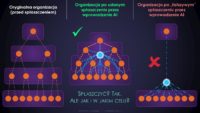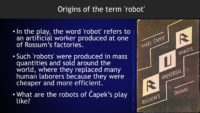Tag: social robotics
Society 5.0: The Human-Centered “Super Smart Society” in Theory and Practice (LinkedIn Group)

The LinkedIn group on “Society 5.0: The Human-Centered ‘Super Smart Society’ in Theory and Practice” was created to facilitate conversation and networking among thought leaders in this area. More information about the group is presented below. If you would enjoy participating in the group, please visit its LinkedIn page and click the button that says “Request to join.” We welcome you to join the conversation! Description of the group The group provides a platform for networking…
Novel Forms of ‘Magical’ Human-Computer Interaction Within the Cyber-Physical Smart Workplace: Implications for Usability and User Experience

International Journal of Research Studies in Management (2019)
ABSTRACT: The growing use of advanced AI, ambient intelligence, augmented reality (AR), and virtual reality (VR) technologies of the sort found within the emerging cyber-physical smart workplace has been described as enabling new forms of human-computer interaction (HCI) that are “magical” in nature. This study shows that from an anthropological perspective, such a workplace environment can indeed be understood as “magical”; however, that “magicality” is a double-edged sword that can potentially both enhance and damage user experience (UX) for workers and other occupants of such environments. First, by analyzing existing social anthropological and philosophical anthropological accounts of magic, typical elements of magical practice are identified. Using Nielsen’s empirical analysis of HCI usability heuristics as a basis, a prospective heuristic evaluation is then carried out for the usability of a generic “magical” environment, in order to identify elements of magical practice that might be expected to enhance or impair user experience when they are required for interaction with the environment. A more specific heuristic usability evaluation is then performed for the “magical” aspects of HCI created by two kinds of constituent technologies that are typical for a cyber-physical smart workplace: those of (a) ambient intelligence and IoT-enabled systems and (b) AR and VR systems. It is shown that the magical aspects of HCI within the emerging cyber-physical smart workplace differ significantly in their potential UX impacts from the magicality involved with earlier forms of computing, and the implications of this fact for the management of future workplaces are identified and discussed.
Megacorp: From Cyberdystopian Vision to Technoeconomic Reality
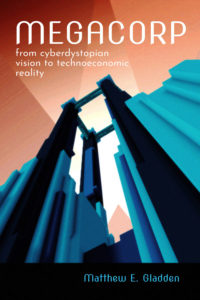
ISBN 978-1-944373-30-6 • Defragmenter Media, 2019 • 322 pages
The image of the “megacorp” – the ruthless, sinister, high-tech global conglomerate that’s grown so large and powerful that it has acquired the characteristics of a sovereign state – is one of the iconic elements of cyberpunk fiction. Such a megacorp maintains its own army, creates its own laws and currency, grants citizenship to employees and customers, and governs vast swaths of cyberspace and the physical world. If it allows traditional governments to survive in some vestigial form, it’s only so they can handle those mundane tasks that the megacorp doesn’t want to deal with itself. By these standards, contemporary companies like Amazon, Apple, Facebook, Google, Microsoft, ExxonMobil, and Walmart aren’t (yet) “megacorps”; they’re the playthings that megacorps gobble up to use for spare parts.
This volume develops a comprehensive intellectual history of the megacorp. It locates forebears of the cyberpunk megacorp not only in earlier fictional works like Čapek’s R.U.R. (1921) and Von Harbou’s Metropolis (1925) but in a string of real-world organizations ranging from the 17th-Century British and Dutch East India Companies to the Pullman Palace Car Company, the Ford Motor Company, and late 20th-Century Japanese keiretsu and South Korean chaebol – as well as in the nearly indestructible oligopolistic “megacorp” described in the pioneering theory of American economist Alfred Eichner.
By investigating the nature of the cyberpunk megacorp as a political entity, commercial entity, producer and exploiter of futuristic technologies, and generator or manipulator of culture, differences are highlighted between the megacorps of “classical” cyberpunk and post-cyberpunk fiction. Classical cyberpunk megacorps – portrayed in novels like Gibson’s Sprawl trilogy, films like RoboCop and Johnny Mnemonic, and games like Cyberpunk, Cyberspace, and Syndicate – are often ostentatiously malevolent and obsessed with short-term financial profits to the exclusion of all else; the over-the-top depictions of such companies serve a dramatic purpose and are not offered by their authors as serious futurological studies. On the other hand, the more nuanced and philosophically rich portrayals of megacorps in post-cyberpunk works like Shirow’s manga The Ghost in the Shell reveal companies that are less overtly evil, possess a broader and more plausible range of long-term strategic goals, and coexist alongside conventional governments in a state of (begrudging) mutual respect. Yet other works like the game Shadowrun depict companies that combine elements of both classical cyberpunk and post-cyberpunk megacorps.
Drawing on such analyses, the volume concludes by exploring how the idea of the post-cyberpunk megacorp anticipated a new type of real-world megacorp – the unfathomably large, fast, and complex “rhizocorp” – that’s now being made possible through ongoing revolutions in the exploitation of robotics, AI, and the Internet of Things – and which threatens to become the dominant economic, political, and sociocultural power of our technologically posthumanized future world.
Who Will Be the Members of Society 5.0? Towards an Anthropology of Technologically Posthumanized Future Societies
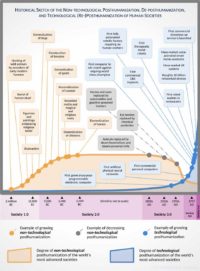
Social Sciences 8, no. 5 (2019)
ABSTRACT: The Japanese Government’s “Society 5.0” initiative aims to create a cyber-physical society in which (among other things) citizens’ daily lives will be enhanced through increasingly close collaboration with artificially intelligent systems. However, an apparent paradox lies at the heart of efforts to create a more “human-centered” society in which human beings will live alongside a proliferating array of increasingly autonomous social robots and embodied AI. This study seeks to investigate the presumed human-centeredness of Society 5.0 by comparing its makeup with that of earlier societies. By distinguishing “technological” and “non-technological” processes of posthumanization and applying a phenomenological anthropological model, the study demonstrates: (1) how the diverse types of human and non-human members expected to participate in Society 5.0 differ qualitatively from one another; (2) how the dynamics that will shape the membership of Society 5.0 can be conceptualized; and (3) how the anticipated membership of Society 5.0 differs from that of Societies 1.0 through 4.0. The study describes six categories of prospective human and non-human members of Society 5.0 and shows that all six have analogues in earlier societies – which suggests that social scientific analysis of past societies may shed unexpected light on the nature of Society 5.0.
Istoty inaczej-ludzkie, quasi-ludzkie i nie-ludzkie jako członkowie przyszłych społeczeństw: Analiza dynamiki posthumanizacji technologicznej
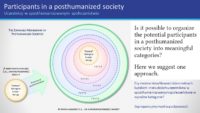
The International Conference on Humans in a Technological World: The Anthropology of Technics • Jagiellonian University, Kraków • May 10, 2019
ABSTRACT: Procesy „posthumanizacji” mogą być rozumiane jako dynamika, za pomocą której społeczeństwo ludzkie włącza do siebie poza „naturalnymi” biologicznymi istotami ludzkimi innych członków, którzy przyczyniają się do struktury, działalności albo znaczenia tego społeczeństwa.
Dzisiaj posthumanizacja identyfikowana jest głównie z włączeniem w ludzkie społeczeństwo zaawansowanej sztucznej inteligencji i robotów społecznych, które ludzie zapraszają do swoich domów i miejsc pracy jako asystentów, współpracowników i towarzyszy. Rozmaite projekty badawcze stwierdzają sposoby, w jakie takie łączenie nie-ludzkiej sprawczości do ludzkiego społeczeństwa stwarza nowe wymiary społecznej rzeczywistości. W niniejszej prezentacji natomiast twierdzimy, że chociaż taka „posthumanizacja technologiczna” faktycznie jest fenomenem dość nowym, może być ona porównana z procesami „posthumanizacji nietechnologicznej,” które od dawna poszerzały społeczeństwa ludzkie o wiele typów nie-ludzkiej sprawczości. Na przykład, wszystkie społeczeństwa, w których ludzie zamieszkiwali i pracowali z zwierzętami domowymi; wierzyli w aniołów, demony albo potwory; albo starali się rozmawiać z zmarłymi krewnymi mogą być rozumiane jako społeczeństwa (nietechnologicznie) posthumanizowane. Starożytne formy posthumanizacji nietechnologicznej i rozwijające się formy posthumanizacji technologicznej będą zidentyfikowane, zanalizowane, i porównane przy zastosowaniu podejścia fenomenologicznego. Prezentacja pokaże, jak społeczeństwa posthumanizowane zarówno technologicznie jak i nietechnologicznie włączają różnych członków, których można klasyfikować jako „naturalne” biologiczne istoty ludzkie, sztucznie rozszerzone istoty ludzkie lub meta-ludzkie, epi-ludzkie, para-ludzkie, albo nie-ludzkie istoty.
Understanding the Cyber-Physical-Social-Intentional ‘Workforce 4.0’: Conceptual Foundations, Architecture, and Context

the VIII Scientific Conference on Modern Concepts and Management Methods: Management 4.0 – Modern Trends in Public, Social and Business Sector • Military University of Technology in Warsaw • December 6, 2018
ABSTRACT: The widespread application of Industry 4.0 technologies relating to social robotics, embodied AI, the Internet of Things (IoT), ubiquitous computing, and advanced human computer interfaces is giving rise to a growing range of “cyber-physical” entities. By building on established definitions and analyses of the cyber-physical system, cyber-physical-social system, cyber-physical society, and cyber-physical-social-thinking space, this text formulates a conceptual framework for understanding the emerging “Workforce 4.0” as a specialized type of “cyber-physical-social-intentional system.” Attention is given to the heterogeneous agency, technological posthumanization, functional decentralization, and planned architectures or spontaneously self-organizing topologies manifested by Workforce 4.0. It is shown how such a workforce is situated within the context of cyber-physical space, a cyber-physical organization, cyber-physical ecosystems, a cyber-physical society, and the larger cyber-physical world.
A Phenomenological Analysis of the Posthumanized Future Workplace
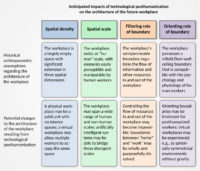
Kwartalnik Nauk o Przedsiębiorstwie 48 (2018), pp. 31-39; MNiSW 2016 List B: 12 points
ABSTRACT: Increasingly, organizations are becoming “technologically posthumanized” through the integration of social robots, AI, virtual reality, and ubiquitous computing into the workplace. Here a phenomenological approach is used to anticipate architectural transformations of the workplace resulting from posthumanization’s challenge to traditional anthropocentric paradigms of the workplace as a space that exists at “human” scale, possesses a trifold boundary, and serves as a spatiotemporal filter.
Dynamics of Technological Posthumanization: Distinguishing the Anticipated Paths of Developed and Emerging Economies
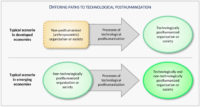
In ICTM 2018: Proceedings of the International Conference on ICT Management for Global Competitiveness and Economic Growth in Emerging Economies, edited by Jolanta Kowal, Anna Kuzio, Juho Mäkiö, Grażyna Paliwoda-Pękosz, and Piotr Soja • University of Wrocław, 2018
ABSTRACT: The processes of “posthumanization” can be understood as those dynamics by which a human organization or society comes to include members other than “natural” biological human beings who contribute to the structure, activities, or meaning of that organization or society. In the world of business, such posthumanization is commonly identified with the growing use of social robots, autonomous AI, and joint human-computer systems to perform work that in earlier eras would have been performed by human beings acting alone. Such “technological” posthumanization is often presented as a new phenomenon occurring largely in those developed economies that are pioneering Industry 4.0 paradigms (e.g., by expanding workplace automation) and that are uniquely positioned to harness such forces to drive economic growth. Here, however, we contend that such emphasis on the novelty of technological posthumanization overlooks forms of non-technological posthumanization that have been at work in human societies for millennia. Such dynamics of non-technological posthumanization have weakened significantly in many developed economies since the mid-20th century; however, they remain relatively strong in emerging economies. In this study, a conceptual framework is developed for identifying and comparing phenomena through which processes of technological or non-technological posthumanization manifest themselves in developed and emerging economies. It is argued that the ongoing and robust experience with non-technological posthumanization possessed by many of the world’s emerging economies may offer them unique and underappreciated psychological, social, and cultural mechanisms for integrating effectively into their enterprises, organizations, and institutions those novel forms of non-human agency that are at work in key Industry 4.0 technologies, like those relating to social robotics, autonomous AI, and advanced human-computer interfaces.
Sapient Circuits and Digitalized Flesh: The Organization as Locus of Technological Posthumanization

ISBN 978-1-944373-21-4 • Second edition • Defragmenter Media, 2018 • 238 pages
Key organizational decisions made by sapient AIs. The pressure to undergo neuroprosthetic augmentation in order to compete with genetically enhanced coworkers. A corporate headquarters that exists only in cyberspace as a persistent virtual world. A project team whose members interact socially as online avatars without knowing or caring whether fellow team members are human beings or robots. Futurologists’ visions of the dawning age of ‘posthumanized’ organizations range from the disquieting to the exhilarating. Which of these visions are compatible with our best current understanding of the capacities and the limits of human intelligence, physiology, and sociality? And what can posthumanist thought reveal about the forces of technologization that are transforming how we collaborate with one another – and with ever more sophisticated artificial agents and systems – to achieve shared goals?
This book develops new insights into the evolving nature of intelligent agency and collaboration by applying the post-anthropocentric and post-dualistic methodologies of posthumanism to the fields of organizational theory and management. Building on a comprehensive typology of posthumanism, an emerging ‘organizational posthumanism’ is described which makes sense of the dynamics of technological posthumanization that are reshaping the members, personnel structures, information systems, processes, physical and virtual spaces, and external environments available to organizations. Conceptual frameworks and analytical tools are formulated for use in diagnosing and guiding the ongoing convergence in the capacities of human and artificial actors that is being spurred by novel technologies relating to human augmentation, synthetic agency, and digital-physical ecosystems. As the first systematic investigation of these topics, this text will be of interest to scholars and students of posthumanism and management and to management practitioners who must grapple on a daily basis with the forces of technologization that are increasingly powerful drivers of organizational change.
Emerging Trends in Organizational Robotics: Management Perspectives
The Diffuse Intelligent Other: An Ontology of Nonlocalizable Robots as Moral and Legal Actors

In Social Robots: Boundaries, Potential, Challenges, edited by Marco Nørskov, pp. 177-98 • Farnham: Ashgate, 2016
ABSTRACT: Much thought has been given to the question of who bears moral and legal responsibility for actions performed by robots. Some argue that responsibility could be attributed to a robot if it possessed human-like autonomy and metavolitionality, and that while such capacities can potentially be possessed by a robot with a single spatially compact body, they cannot be possessed by a spatially disjunct, decentralized collective such as a robotic swarm or network. However, advances in ubiquitous robotics and distributed computing open the door to a new form of robotic entity that possesses a unitary intelligence, despite the fact that its cognitive processes are not confined within a single spatially compact, persistent, identifiable body. Such a “nonlocalizable” robot may possess a body whose myriad components interact with one another at a distance and which is continuously transforming as components join and leave the body. Here we develop an ontology for classifying such robots on the basis of their autonomy, volitionality, and localizability. Using this ontology, we explore the extent to which nonlocalizable robots—including those possessing cognitive abilities that match or exceed those of human beings—can be considered moral and legal actors that are responsible for their own actions.
Posthuman Management: Creating Effective Organizations in an Age of Social Robotics, Ubiquitous AI, Human Augmentation, and Virtual Worlds
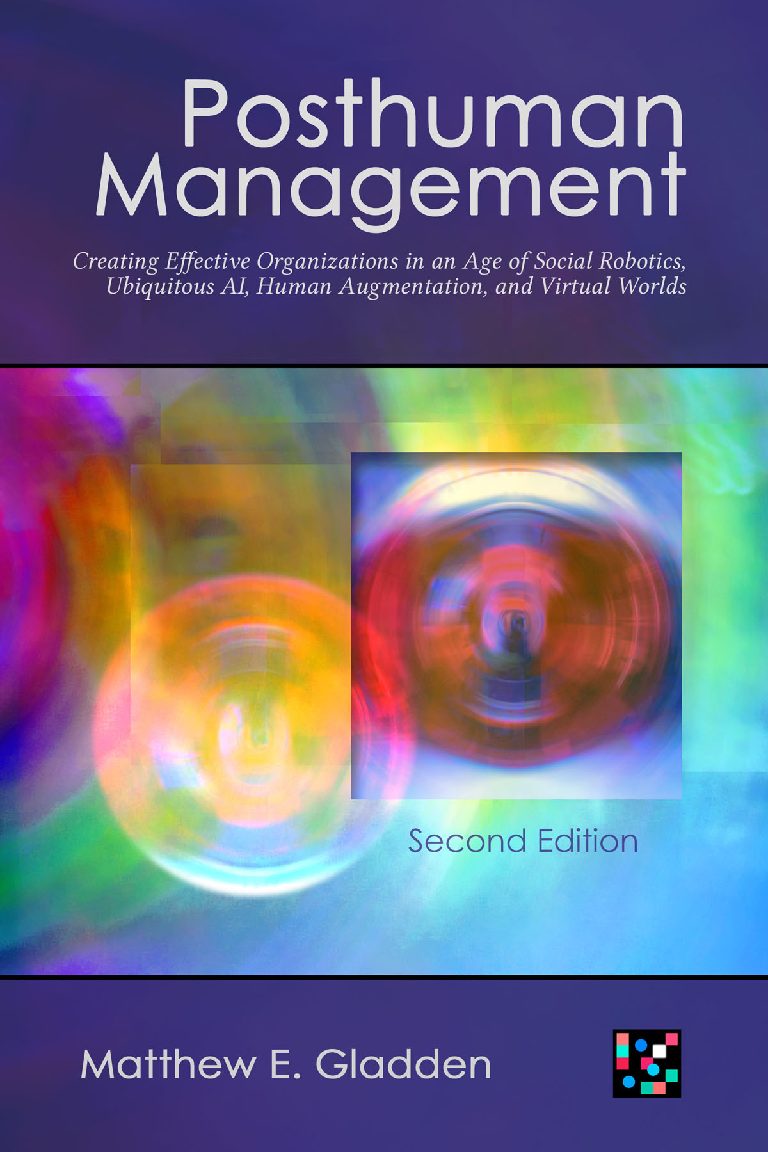
ISBN 978-1-944373-05-4 • Second edition • Defragmenter Media, 2016 • 442 pages
What are the best practices for leading a workforce in which human employees have merged cognitively and physically with electronic information systems and work alongside social robots, artificial life-forms, and self-aware networks that are ‘colleagues’ rather than simply ‘tools’? How does one manage organizational structures and activities that span both actual and virtual worlds? How are the forces of technological posthumanization transforming the theory and practice of management?
This volume explores the reality that an organization’s workers, managers, customers, and other stakeholders increasingly comprise a complex network of human agents, artificial agents, and hybrid human-synthetic entities. The first part of the book develops the theoretical foundations of an emerging ‘organizational posthumanism’ and presents conceptual frameworks for understanding and managing the evolving workplace relationship between human and synthetic beings. Subsequent chapters investigate concrete management topics such as the likelihood that social robots might utilize charismatic authority to inspire and lead human workers; potential roles of AIs as managers of cross-cultural virtual teams; the ethics and legality of entrusting organizational decision-making to spatially diffuse robots that have no discernible identity or physical form; quantitative approaches to comparing the managerial capabilities of human and artificial agents; the creation of artificial life-forms that function as autonomous enterprises which evolve by competing against human businesses; neural implants as gateways that allow their human users to participate in new forms of organizational life; and the implications of advanced neuroprosthetics for information security and business model design.
As the first comprehensive application of posthumanist methodologies to the field of management, this volume will be of use to scholars and students of contemporary management and to management practitioners who must increasingly understand and guide the forces of technologization that are rapidly reshaping organizations’ form, dynamics, and societal roles.
Posthuman Robotics and the Challenge to Human Agency: Societal and Managerial Implications
Leveraging the Cross-Cultural Capacities of Artificial Agents as Leaders of Human Virtual Teams
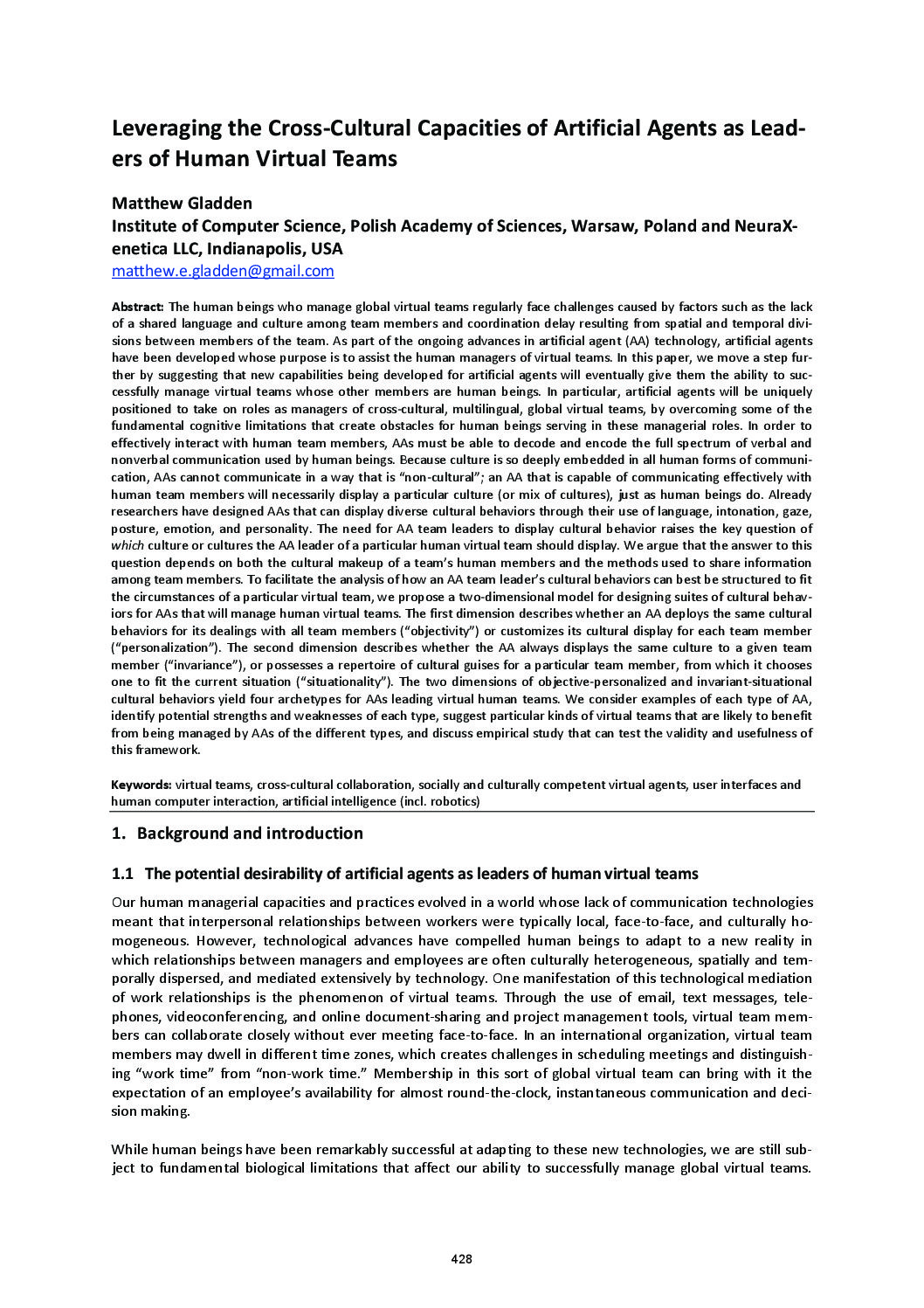
In Proceedings of the 10th European Conference on Management Leadership and Governance, edited by Visnja Grozdanić, pp. 428-35 • Reading: Academic Conferences and Publishing International Limited, 2014
ABSTRACT: The human beings who manage global virtual teams regularly face challenges caused by factors such as the lack of a shared language and culture among team members and coordination delay resulting from spatial and temporal divisions between members of the team. As part of the ongoing advances in artificial agent (AA) technology, artificial agents have been developed whose purpose is to assist the human managers of virtual teams. In this paper, we move a step further by suggesting that new capabilities being developed for artificial agents will eventually give them the ability to successfully manage virtual teams whose other members are human beings. In particular, artificial agents will be uniquely positioned to take on roles as managers of cross-cultural, multilingual, global virtual teams, by overcoming some of the fundamental cognitive limitations that create obstacles for human beings serving in these managerial roles.
In order to effectively interact with human team members, AAs must be able to decode and encode the full spectrum of verbal and nonverbal communication used by human beings. Because culture is so deeply embedded in all human forms of communication, AAs cannot communicate in a way that is “non-cultural”; an AA that is capable of communicating effectively with human team members will necessarily display a particular culture (or mix of cultures), just as human beings do. Already researchers have designed AAs that can display diverse cultural behaviors through their use of language, intonation, gaze, posture, emotion, and personality. The need for AA team leaders to display cultural behavior raises the key question of which culture or cultures the AA leader of a particular human virtual team should display. We argue that the answer to this question depends on both the cultural makeup of a team’s human members and the methods used to share information among team members.
To facilitate the analysis of how an AA team leader’s cultural behaviors can best be structured to fit the circumstances of a particular virtual team, we propose a two-dimensional model for designing suites of cultural behaviors for AAs that will manage human virtual teams. The first dimension describes whether an AA deploys the same cultural behaviors for its dealings with all team members (“objectivity”) or customizes its cultural display for each team member (“ personalization”). The second dimension describes whether the AA always displays the same culture to a given team member (“invariance”), or possesses a repertoire of cultural guises for a particular team member, from which it chooses one to fit the current situation (“situationality”). The two dimensions of objective-personalized and invariant-situational cultural behaviors yield four archetypes for AAs leading virtual human teams. We consider examples of each type of AA, identify potential strengths and weaknesses of each type, suggest particular kinds of virtual teams that are likely to benefit from being managed by AAs of the different types, and discuss empirical study that can test the validity and usefulness of this framework.
The Social Robot as ‘Charismatic Leader’: A Phenomenology of Human Submission to Nonhuman Power
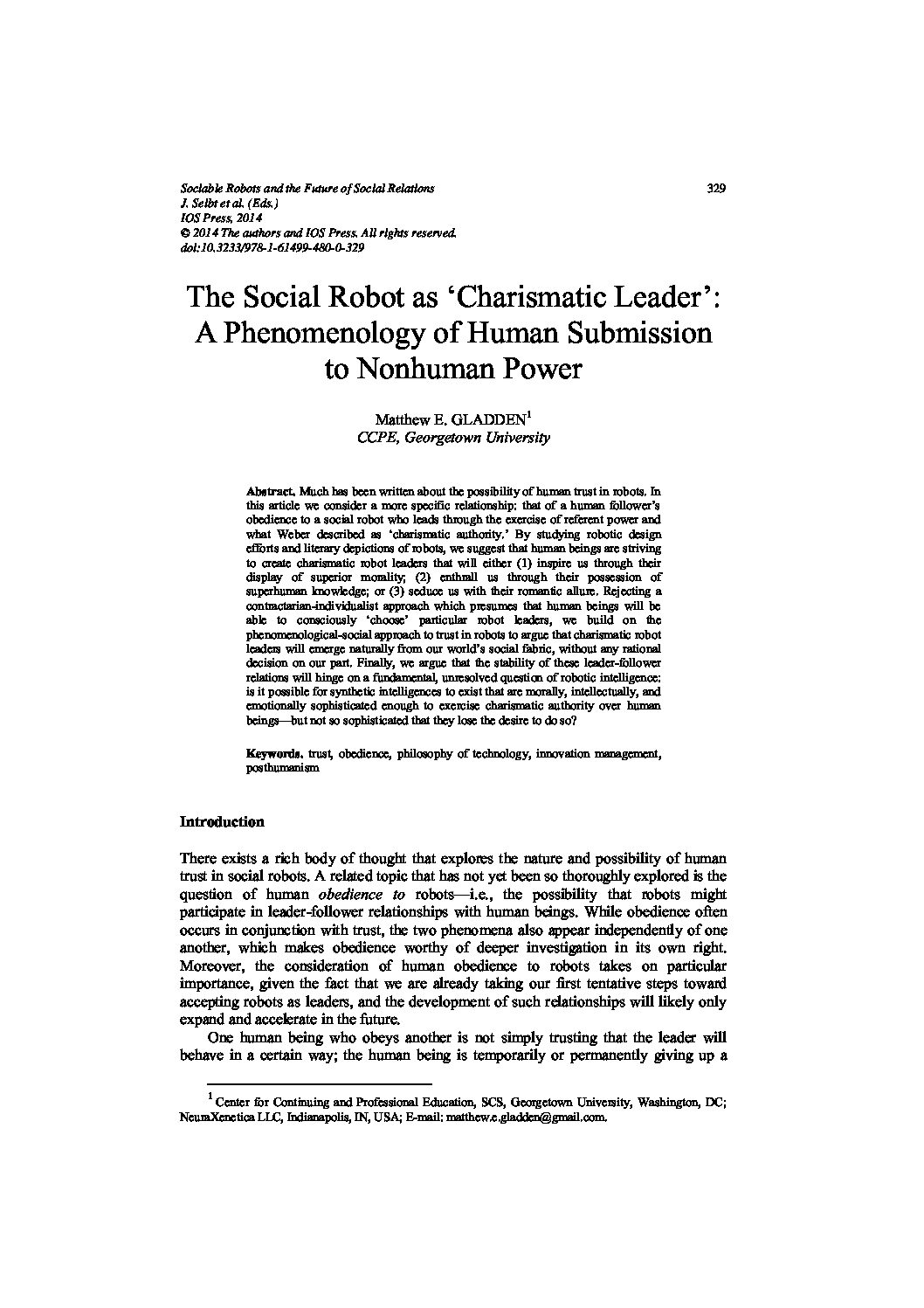
In Sociable Robots and the Future of Social Relations: Proceedings of Robo-Philosophy 2014, edited by Johanna Seibt, Raul Hakli, and Marco Nørskov, pp. 329-39 • Frontiers in Artificial Intelligence and Applications 273 • IOS Press, 2014
ABSTRACT: Much has been written about the possibility of human trust in robots. In this article we consider a more specific relationship: that of a human follower’s obedience to a social robot who leads through the exercise of referent power and what Weber described as ‘charismatic authority.’ By studying robotic design efforts and literary depictions of robots, we suggest that human beings are striving to create charismatic robot leaders that will either (1) inspire us through their display of superior morality; (2) enthrall us through their possession of superhuman knowledge; or (3) seduce us with their romantic allure. Rejecting a contractarian-individualist approach which presumes that human beings will be able to consciously ‘choose’ particular robot leaders, we build on the phenomenological-social approach to trust in robots to argue that charismatic robot leaders will emerge naturally from our world’s social fabric, without any rational decision on our part. Finally, we argue that the stability of these leader-follower relations will hinge on a fundamental, unresolved question of robotic intelligence: is it possible for synthetic intelligences to exist that are morally, intellectually, and emotionally sophisticated enough to exercise charismatic authority over human beings—but not so sophisticated that they lose the desire to do so?
Managerial Robotics: A Model of Sociality and Autonomy for Robots Managing Human Beings and Machines
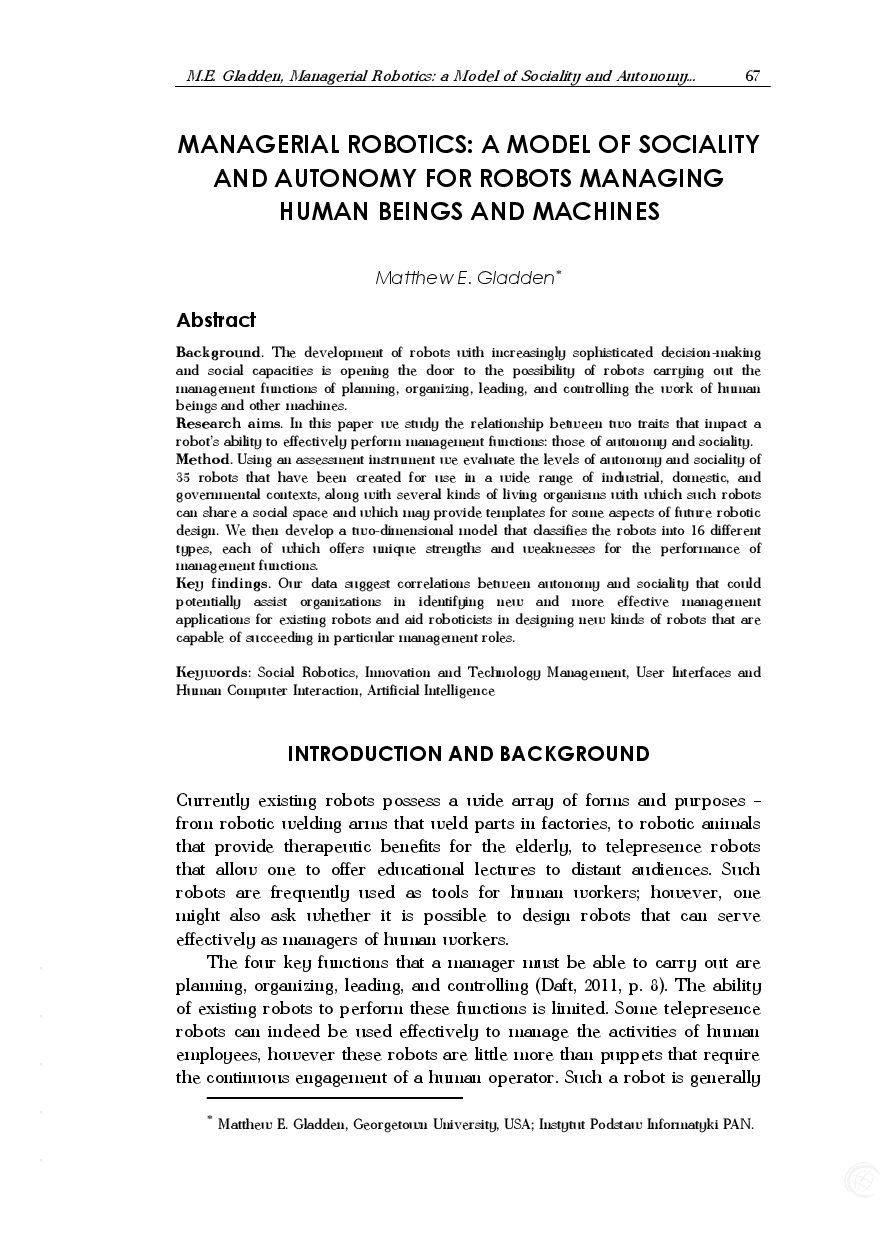
International Journal of Contemporary Management 13, no. 3 (2014), pp. 67-76; MNiSW 2014 List B: 9 points
ABSTRACT: The development of robots with increasingly sophisticated decision-making and social capacities is opening the door to the possibility of robots carrying out the management functions of planning, organizing, leading, and controlling the work of human beings and other machines. In this paper we study the relationship between two traits that impact a robot’s ability to effectively perform management functions: those of autonomy and sociality. Using an assessment instrument we evaluate the levels of autonomy and sociality of 35 robots that have been created for use in a wide range of industrial, domestic, and governmental contexts, along with several kinds of living organisms with which such robots can share a social space and which may provide templates for some aspects of future robotic design. We then develop a two-dimensional model that classifies the robots into 16 different types, each of which offers unique strengths and weaknesses for the performance of management functions. Our data suggest correlations between autonomy and sociality that could potentially assist organizations in identifying new and more effective management applications for existing robots and aid roboticists in designing new kinds of robots that are capable of succeeding in particular management roles.
